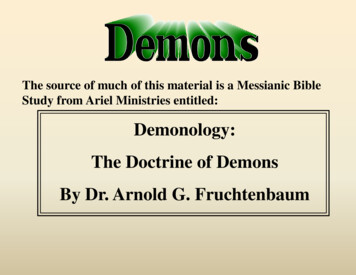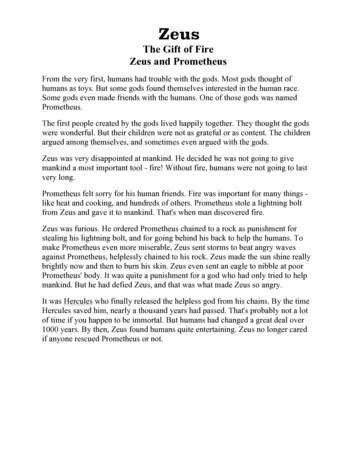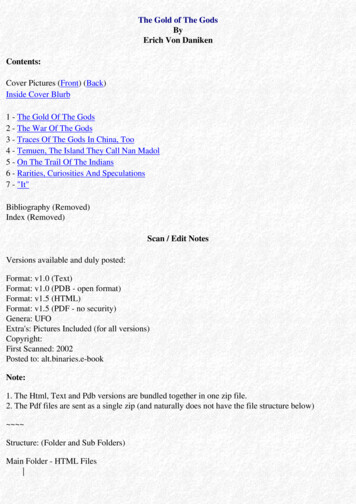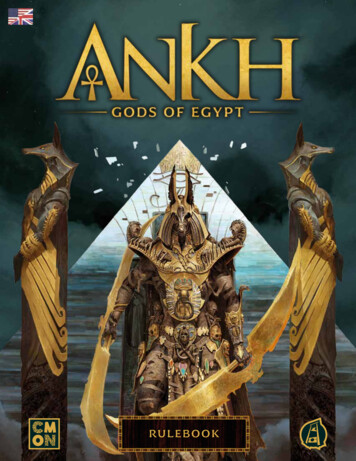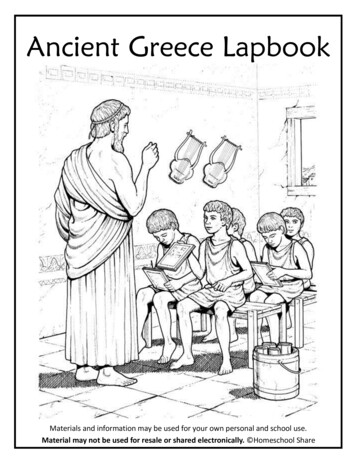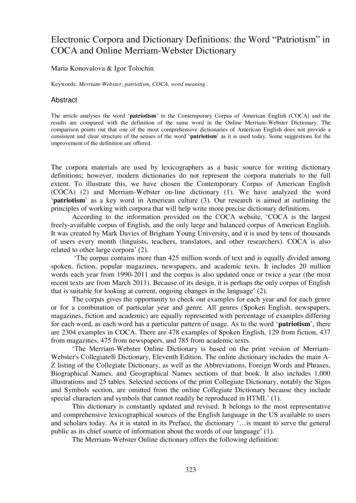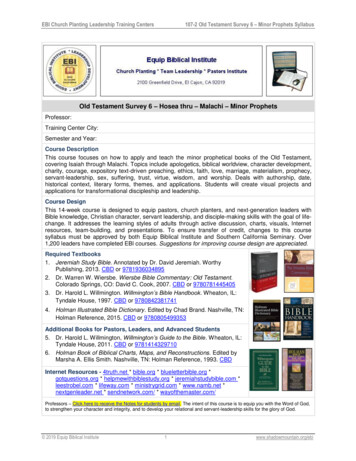
Transcription
AN ILLUSTRATED DICTIONARYGods, Demons and Symbolsof Ancient MesopotamiaJEREMY BLACK AND ANTHONY GREENIllustrations by Tessa Rickards
Gods, Demons andSymbols ofAncient MesopotamiaAn Illustrated DictionaryJeremy Black and Anthony GreenIllustrations by Tessa RickardsTHE BRITISH MUSEUM PRESS
Jeremy BlackThe late Dr Black, formerly Director of the BritishSchool of Archaeology in Iraq, was a Fellow of WolfsonCollege, Oxford, and University Lecturer in Akkadian.He was the author of several studies on Sumerian andBabylonian literature and ancient philology, and headedthe Electronic Text Corpus of Sumerian Literatureproject (http://etcsl.orinst.ox.ac.uk )Anthony GreenDr Green has formerly held the positions of Fellow of theBritish School of Archaeology in Iraq, J. Paul GettyPostdoctoral Research Fellow in the History of Art at theUniversity of Pennsylvania, G.A. Wainwright ResearchFellow in Near Eastern Archaeology at Oxford University,and Alexander von Humboldt Research Fellow at the FreeUniversity of Berlin. He is currently Shinji ShumeikaiSenior Academic Research Fellow in Near Eastern Art andArchaeology at the Free University of Berlin. He hasconducted extensive archaeological fieldwork in Syria andIraq and writes on ancient Mesopotamian art andarchaeology.Tessa RickardsTessa Rickards is a freelance archaeological illustratorspecialising in ancient Mesopotamia. She has worked as an illustrator on numerous international excavations in the MiddleEast. She is an MA graduate of the Institute of Archaeology,University College London.Front cover: Green jasper seal depicting a conflict between twoheroes, a bull-man, a bull and a lion. Dated 225o BC, originunknown.Frontispiece: A nude winged goddess on a large-scale baked clayplaque in high relief The deity portrayed may be an underworldaspect of Istar (Inana). Old Babylonian or Isin-Larsa Period.Ht. 0.49 m.1992 The Trustees of The British MuseumPublished by The British Museum PressA division of The British Museum Company Ltd46 Bloomsbury Street, London wCIB 3QQ First published 1992Second edition 1998Reprinted 2003, 2004British Library Cataloguing in Pubiication DataA catalogue record for this book is available from theBritish Library.ISBN 0 7141 17056Designed by James ShurmerCover design by Andrew ShoolbredTypeset in Ehrhardt and printed in Great Britain byThe Bath Press, Bath
Authors' noteThe names and concepts of Mesopotamian religion are recorded in twolanguages, Sumerian and Akkadian. Where possible, words have been listedin this dictionary in their Sumerian form, with only a cross-reference underthe Akkadian name. Thus the goddess Ištar (Akkadian), for instance, is dealtwith under her Sumerian name Inana. However, within the entries, theSumerian or Akkadian name is used as appropriate, depending on thesources or periods referred to. A number of Mesopotamian names arecommonly used in modern books (including this one) in Greek or Latinforms (especially place-names, e.g. (Greek) Babylon for Akkadian Bâbili), orin a form in which they occur in the Authorised Version of the Old Testament (especially the names of Assyrian kings, e.g. Sennacherib for AkkadianSin-ahhé-eriba). Similarly, archaeological sites are sometimes known bytheir modern Arabic names, e.g. Abù Shahrain for Sumerian Eridu.Of course we have no exact information on the pronunciation of theAkkadian or Sumerian languages, but scholars have reconstructed anapproximate system based on comparison with other Semitic languages andon ancient transcrip tions into Greek. A simplified guide to this is as follows:All letters are pronounced.The four vowels a e i u are always pronounced as in Italian (i.e. as 'ah', ay', ee', 'oo').The signs - or over vowels mark them as long.The letter g is always hard, as in god', not soft, as in 'gem'.The symbols indicates the sound sh, as in 'shop'.The symbol g in Sumerian words indicates the sound ng, as in 'sing'.The letters s, t and q indicate 'emphatic' forms of the consonants s, t and k(and can be pronounced as s, t and k).The letter h always indicates the guttural sound ch, as in loch'. This meansthat -sh- indicates two sounds — sh followed by guttural ch — not just sh.Words beginning with s are listed separately after those beginning with s.Because our understanding both of the cuneiform writing system and ofthe languages written in it has improved enormously since the early days ofAssyriology (as this study has come to be known), ancient names sometimes5
Authors' noteappear written differently in early publications. For instance, we now knowthat in the name of the god Ninurta, the sign is should be read as URTA, but inolder books Ninib' will be found. This corresponds to the same group ofsigns in Sumerian, but is now out of date as a transcription. The books in thereading list on pages 191-2 all use the transcriptions currently favoured bythe majority of scholars.Illustrations have been chosen to accompany many of the entries in thisbook. Drawings are particularly useful to show iconographic details orscenes, or the occasional relatively simple object. Most have been drawn byTessa Rickards especially for this work. In other cases photographs havebeen preferred in order to give a clearer picture of the objects themselves.Although each of these illustrations has been selected with a particular themein mind, they often contain elements which illustrate aspects covered in otherentries. Therefore, each illustra ti on has been numbered in sequence and thenumbers of any that are relevant are printed in the margins of the text. Visualrepresentations of some of the supernatural beings and the major symbols ofthe gods in art are given in illustrations 53 and 76.6
IntroductionAncient Mesopotamia was the home of some of the world's earliest cities, andthe place where writing was invented. For these two major developmentsalone — urban society and literate society — it might justly be titled the 'cradleof civilisation', but in its literature, its religious philosophies and no less inits art it can also be placed firmly as the direct ancestor of the Western world.Our knowledge of the civilisation of ancient Mesopotamia is constantlyexpanding. A hundred and fifty years after the first modern excavations,archaeological work in the Near East continues unabated and new discoveries are constantly being made which add to, reshape and refine ourassessments of some of the most staggering human achievements of antiquity. At the sites of ancient settlements and in the museums of Iraq and ofother countries one can contemplate and wonder at the monuments, arts,handicrafts and utensils of daily life of the Mesopotamians. Thanks to theMesopotamians' own greatest invention — writing — and modern decipher-1 Worshippers starewide-eyed at the heavens.Limestone statues found withnumerous others buried in ashrine of an Early DynasticEšnunnamoderntemple at EsTell Asmar). The eyeballs areof inlaid shell. Ht. of eachstatue 0.34m.7
Introduction2 (below) A typical ancient mound (or tell) site of southern Mesopotamia.A view of Eridu.3 (right) Cuneiform (wedge-shaped) writing. The names and titles ofHammurabi, king of Babylon in the early second millennium BC, from thestone monument inscribed with his Laws.5iraMinerMaII.0i4BrkA uTitMlment of the languages in which they expressed themselves, we can read theirliterature, reconstruct their history and learn something of their thoughts.This is not to say that vast amounts of research do not still remain to bedone. If some areas of history can be reconstructed down to the smallestdetail, there are periods where enormous gaps in our knowledge remain. Ifnumerous copies survive of one poem, there are many others of which onlyfragments have been recovered. If we can trace the use and meaning of somereligious motifs throughout thousands of years, there remain some whosesignificance still eludes us completely. There is a constant need for skilledarchaeologists and scholarly researchers to sift through the great wealth ofevidence coming to light. But for the general reader, several reliableaccounts of Mesopotamian civilisation, together with the story of how it hasbeen revealed to us, are now available (see pages 191-2). There are lavishlyillustrated books showing the full range of ancient art, from temple architecture and palace reliefs to cylinder seals and filigree jewellery. And gradually,accurate and readable modern translations of the extensive Sumerian andBabylonian literatures are appearing, together with explanatory studies.This book does not attempt to emulate the breadth or detail of such works,but rather to serve as an introductory guidebook for those who are tempted toread for the first time about ancient Mesopotamia, and especially to those8
Introductionwhose interest is drawn to the belief systems of ancient peoples as revealed intheir art and in their writings. It is not intended to be a complete survey ofreligion and beliefs, and necessarily reflects the particular interests of theauthors. There are a number of extended essays, which are complemented byshorter entries covering the most interesting individual deities, mo tifs andsymbols, and a selection of other topics. Inevitably much has been omitted.The uses to which cuneiform writing was put in Mesopotamia haveensured that, in addition to administrative, commercial and historical documents, extensive a ttention was paid to the recording of religious matters. Inpre-mode rn societies, religion had a much more pervasive influence on everyaspect of life: government and politics, social relations, education and literature were all dominated by it. Thus in this context we subsume under theterm religion a wide sweep of ideas and beliefs ranging from magic at oneextreme to philosophy at the other. A very considerable por tion of ancient art,too, was produced within this broad religious sphere, or using mo tifs andimages derived from religious tradi tions. The gods, goddesses and demons,the motifs, symbols and religious beliefs of the several thousand years ofMesopotamian civilisation are bewilderingly complex to the modern readerwho stands on the threshold of that world. The authors hope that this dictionary can be used as a first reference book to accompany them on theirjourney within.Peoples and placesThe cultures of Mesopotamia grew up through the interplay, clash andfusion of different peoples, with their separate social systems, religious beliefs and pantheons, languages and political structures. Uniquely, Mesopotamia was a crossroads and mel ting-pot for vastly different groups ofpeoples over thousands of years from the prehistoric periods to the Persianconquest. Moreover, although the potential productivity and prosperity ofthe region was the impetus for extensive and prolonged immigra tion, the areahas no real geographical unity, nor any obvious or permanent capital, so thatit is in marked contrast to civilisa tions of greater uniformity, such as Egypt.There are, however, a few unifying factors, such as the cuneiform script forwriting, the pantheon of gods which through syncretism and assimila tionwas an evolving tradition, and the highly conservative works of art, especiallyreligious art. In these fields, at least, it is therefore possible to speak ofsomething uniquely 'Mesopotamian'.The map on page to shows the ancient Near East. Mesopotamia — 'the landbetween two rivers' — was a name given first by the Greeks to the exceptionallyfertile river valley of the twin streams Tigris and Euphrates, which both risein the mountains of Turkey. The Tigris flows faster and deeper, has more9
',tes Ebla4 Sites of ancient Mesopotamia mentioned in the text.erusalemMEDITERRANEANsEAUgaritA rslan TashsamsatAssur. Borsippa Dilbat Baby/onEriduUruk Larsaal-'Ubaid Ur NippurIsin Adab ;lamaSuruppâg I agauDilmunTHE GULF susa Eridu ancient place name Abu salabikh modern place nameEsnunna Dûr-Kurigalzu TutubTell Agrab Dér Nérebtumsippar samarraNuziTell Brak NinevehImgur-Enlil et Arba'il---- Kalhu Glee'Tell al-RimahDûr-Sarkén . shanidarMa tai.c4lJ
Introductionaffluents and is more prone to flood than the Euphrates, which follows a morecircuitous course until it joins the Tigris in the very south of Iraq and theyfl ow together as the Shatt al- Arab down to the Gulf (of which the shorelinemay have been slightly further north in ancient times). More generally, theterm Mesopotamia is used to cover the whole extent of the civilisation associated with this region, so that the term effectively includes an area extendingoutside the borders of modern Iraq into Syria, and parts of Turkey and Iran.At its greatest extent, the in fluence of Mesopotamian civilisation could be feltas far away as modern Iran, Lebanon, Jordan, Israel, Egypt, Saudi Arabiaand the Gulf States, Turkey, Cyprus and Greece; there were also commercial connections with the Indus Valley (Pakistan). Mesopotamia proper canbe divided into two regions, corresponding to two once-great empires and,later, to two provinces of the Persian Empire. The northern area is Assyria,named after its original capital city Ašsur; the southern is Babylonia, namedafter its principal city Babylon: the boundary between the two lay a little northof modern Baghdad. Earlier Babylonia was made up of two regions: asouthern area called by modern archaeologists Sumer (anciently S umerum)and a northern half called Akkad, and it is from these two areas that theprincipal ancient languages of Mesopotamia take their names: Sumerian, anagglutinative, ergative language of which no related language is preserved,and Akkadian, a member of the Semitic family of languages (including alsoArabic, Hebrew, Aramaic, Phoenician and Ugaritic).The people who invented writing in Sumer in roughly 34.00 BC almostcertainly spoke Sumerian. They had no traditions of having come to thatregion from elsewhere and, although the archaeological evidence is notabsolutely conclusive, there seems no reason necessarily to assume that theywere not the descendants of the earlier, prehistoric peoples of Sumer.Although in time Sumerian spread, as a written language, as far as westernSyria, and was widely used as a cultural language throughout Mesopotamianhistory, its homeland was Sumer, where it was probably spoken as a vernacular until about 2000 BC. None of the other languages related to Sumerian wasever written down and so they remain unknown to us.The Sumerians, then, were the originators of the early high civilisation ofsouthern Mesopotamia from shortly before 3000 BC. As their language diedout as an everyday idiom, they were probably absorbed into the other peoplesof the region, who spoke languages of the Semitic family. Scribes withSemitic names are attested in northern Babylonia almost as early as theearliest writing we can read, and they probably spoke Old Akkadian, theearliest recorded form of a Semitic language. Akkadian is used as a generalterm for this language, of which the later forms Assyrian and Babylonian arealso dialects. Other early Semitic languages are Amorite, which we knowonly from personal names (the Amorites were apparently a largely nomadicII
Introductionpeople) and the recently discovered language of Ebla in western Syria,which seems to have been very close to Old Akkadian. Akkadian first came tothe fore during the period of the Akkadian kingdom (see below), but it wasAssyrian and Babylonian, in their respec tive areas, which gradually took overas Sumerian died out in the south.A third ethnic group, the Hurrians, were settled in a wide band acrossnorthern Mesopotamia, most of Syria and the very south-east of Turkey by atleast 2000 BC. These agricultural people spoke a language of their own, ofwhich the only known relative is the later Urartian; the extent to which theypossessed a definable civilisation of their own, as opposed to borrowing theirreligion and art from their neighbours, is still debated. The climax of theirhistory was the forma ti on of the Hurrian kingdom of Mitanni, whichreached its high point around 1400 BC. More than a century later, there stillseems to have been a considerable number of Hurrians in Assyria and northeastern Babylonia, but thereafter they must have been absorbed into thegeneral population.The names of many tribal and nomadic peoples are mentioned throughoutMesopotamian history, especially the often warlike groups who were eitherattracted down into the fer ti le river valleys from the inhospitable ZagrosMountains to the east, or were driven into Mesopotamia by the pressure ofi2Assyrian scribesrecording the events ofthe king's campaign.One writes with a stylusin cuneiform Akkadianon a clay tablet, theother writes in alphabetic Aramaic, orperhaps makes sketches,on parchment. From amonumental muralpainting in the mainreception room of thepalace at the provincialcapital of KârKâr—Sulmânuaaridil Barsip) onthe Middle Euphrates,reign of King TigTiglathpilesert (744744-727)or slightly later.12
Introductionother groups behind them. Such a people were the Gutians, whose entry onthe Mesopotamian scene coincided with, if it was not actually responsiblefor, the decline and fall of the Akkadian kingdom. According to somesources, a series of Gutian leaders ruled southern Mesopotamia until aSumerian dynasty was eventually able to reassert itself.A similar story can be told about the Kassites, a people who are firstmentioned in Syria in the eighteenth century BC but who moved graduallydown into Babylonia and eventually controlled it. A dynasty of Kassite kingsruled Babylonia for half a millennium thereafter. We know very little aboutthe origins of the Kassites, and only a few words of their unclassifiablelanguage and the names of some of their gods: despite their position ofpolitical control, they appear to have contributed relatively little to the cultureof the lands they ruled.It was inevitable that the stable, urban cultures of Babylonia and Assyriashould be infiltrated by nomadic elements who took advantage of the opportunity to gain material benefit, whether peacefully or by raiding. There isgood evidence that both the earliest Assyrians (with their kings who lived intents') and the earliest Babylonians were of Amorite origin. During thesecond millennium a further wave of Semitic nomads entered history, first astroublesome raiders, then as mercenaries and gradually as settled elementsin the population. These were the Aramaeans, who may have developedoriginally out of one particular Amorite tribal clan. By soon after i000 BC it islikely that their language, Aramaic, was widely used as an everyday vernacular in both Assyria and Babylonia as well as over most of Syria and Palestine(where Hebrew also was still spoken). The Neo-Babylonian Empire foundedin 626 BC may also have had its origins in an Aramaic-speaking tribal confederation, the Chaldaeans. In this way, there was throughout Mesopotamianhistory a constant interference with the settled, traditional civilisation of thegreat ancient cities by a variety of groups moving into the area from themountain fastnesses to the east or the rolling plains to the north-west. Thesenew ethnic and cultural infusions were an important factor in reviving andpreserving the long-lived culture which they found in the river valleys.A great power to the north-west of Mesopotamia was the kingdom of theHittites, with its capital at Hattusas in central Turkey. This people, whospoke the earliest recorded Indo-European language, had become verypowerful at a time when Babylonia was weak, and a Hittite king was able toattack Babylon itself during the seventeenth century BC, although their kingdom never made any serious headway with expansion into the Mesopotamianarea, and after 1200 BC was no longer a force to be reckoned with. Similarlythe kings of Elam, located in south-west Iran to the east of Babylonia, wereable at various times to make forays deep into Babylonian territory, on oneoccasion carrying away the cult statue of the Babylonian national god,13
IntroductionMarduk. For short periods the Elamites (who spoke a language unrelated toany other surviving language) were able to control parts of Babylonia, even torule it, and some cultural transfer seems to have taken place: certain aspectsof Babylonian magic and religion seem to derive from Elam.Mythology and legendsThe myths and legends of ancient Mesopotamia form an exceptionallydiverse collec ti on of material. Some are preserved in Sumerian and some inAkkadian, the earliest from 2500 BC and the latest from the first century BC.As might be expected from such a broad field, they display very considerablevariety, and in many cases there are several different versions of a narra tive,originating from different localities or in different periods, some of whichdirectly contradict other versions. Some myths were created within the historical period; others are of indeterminate antiquity. No doubt they weretransmitted orally in many forms and on many occasions: however, the onlyform in which they survive is of course the written form. It is essential to bearin mind that every myth or legend preserved in written form is preserved aspart of a (perhaps fragmentary) work of literature which was created in aspecific historical environment and which was intended to serve a specificliterary aim. In this way they can be compared to the use of Greek myths by6 The god Ninurta or Adad pursuing a leonine bird-monster, perhaps the Anzû orAsakku. From a cylinder seal of the Neo-Assyrian Period. See ill. 117.4
Introductionthe Greek tragedians, and the same cautions apply. There is no homogeneous system and it makes no sense to talk of the character of Mesopotamianmyth', except in the most general terms. The very distinction between myth,legend and history is of course a largely modern one.A particular problem which must also be mentioned is the evident disparitybetween those literary versions of the myths which happen to survive and thegraphic versions of mythical themes used in various heraldic and iconic waysin Mesopotamian fine art. This has been a source of great difficulty in theinterpretation of ancient works of art. It serves to emphasise the extraordinaryrichness of the Mesopotamian heritage, since it seems to imply that manymythical themes used in art refer to narratives of which no written versionhas yet been recovered.Most of the Akkadian works incorporating myths and legends which havebeen studied and edited so far are now available in English translations, butnumbers of Sumerian compositions are available only in foreign languageeditions or in doctoral dissertations (which may not be readily available), orhave not yet been published. Apart from these, there are many that have notyet even been read or studied in modern times.Interest in the Bible has been an important stimulus to modern research inand about the ancient Near East in general. The very diverse collection ofprose and poetry, written down over a considerable period of time in Hebrew,Aramaic and Greek, which makes up the Bible, is the product of a world bothalien to that of Mesopotamia and in which nonetheless many echoes ofMesopotamian society, beliefs and history are to be found. This raises thecomplex question of the e xi stence of various oral traditions throughout thewhole Near East, influencing each other. The Mesopotamian evidence happens to be attested in writing at much earlier dates, but this need not lead tothe conclusion that it was therefore the origin of all similar themes occurringlater on.Art and iconographyThe interpretation of elements in the religious a rt of ancient Mesopotamiaencounters the difficulty that direct captions' (that have been so fundamentally useful in the study of Egyptian and Classical a rt) are extremely rare andhardly ever straightforward. The following examples may help to illustratethis point. The symbols of the gods shown on Babylonian kudurru stones(stones recording royal land grants) occasionally have captions identifyingthe deities symbolised. All the known examples of these had been looted fromBabylonia and taken to the Elamite city of Susa, and the labels were perhapsadded there for the benefit of the Elamites. Assyrian and Babylonianfigurines of supernatural beings are sometimes inscribed with-5
Introduction7 Symbols carved on a c.13th-century Bc Babylonian kudurru-stone, inscribed with thenames of the deities represented. Found at Susa, in south-western Iran, where it hadbeen taken in antiquity as a prize of war.incanta ti ons which name the creature concerned (for example, as Huwawa,Lamastu or Pazuzu). In the Neo-Assyrian Period, clay figurines of beneficent beings were also often inscribed with magical spells. These do not namethe creatures directly, but they are named in ritual texts which give instructions for the figurines' manufacture, the writing to be put on each type andthe sites of placement or burial within a building. Furthermore, on stelae androck reliefs erected by Assyrian kings (or exceptionally governors) to commemorate special events, there is sometimes a one-to-one correlation in bothnumber and order between the gods invoked in the inscrip ti on and thesymbols depicted. Yet more usually this is not so. For the kudurrus, moreover,the gods invoked in the curses of the main text are never those symbolised onthe stone.Sometimes named supernatural beings are described in texts in a waywhich makes it possible to relate them to extant art. Once again, the NeoAssyrian rituals concerning the placing of magical figu ri nes, for example,refer to types of creature which can easily be identified even though thefigurines of these particular creatures were never inscribed. An example isthe Sages (apkallû) with the faces of birds, and wings, carrying in their righthands a "purifier" (mullilu) and in their left a bucket (banduddû)', or anotherset of Sages cloaked in the skins of fishes'. Similarly the inscrip ti on on one16
Introduction8 (below) The image of the face of the demonHuwawa or Humbaba, formed from the pattern ofanimal entrails, as used in divination. Baked claymodel, inscribed on the reverse: 'If the entrails looklike the face of Huwawa .' Probably OldBabylonian, from Sippar.Ht. 8o mm.9 (right) Plaque-iigurine of sun-dried clay.Neo-Assyrian, probably 7th-century BC, found in abrick box buried in the foundations of a building atAššur. The piece depicts the protective god Lahmu(Hairy'), inscribed on his arms: 'Get out, evildemon!' and 'Come in, good demon!'. Ht. 128 mm.10 Twelve symbols carved onthe Assyrian rock reliefs atBavian (Khinnis) by order ofKing Sennacherib (reignedaccom7o4-681BC). The accpanyingscription invokestwelve deities in corcorresAsšur,pondingder, namely Assu, Enlil, Ea, Sin, SamSamaš,ad, Marduk, Nabû,Nergal (?), Istar and theSeven.i7
Introduction11 (above) Neo-Assyrianplaque-figurines of the so-calledgriffin-demon, representing the SevenSages (apkallû) in the guise of birds.Sun-dried clay. Three from a groupof seven figurines found together in abrick box buried in the foundations ofroyal palace of King Adad-nirâri ni(reigned 810-783Bc) at Kalhu(modern Nimrud). Hts. all 14omm.12 Neo-Assyrian figurines ofthe so-called fish-garbed figures,representing the Seven Sages(apkallu) in the guise of fish.Sun-dried clay. (left) One of a groupof seven figurines found together in abrick box buried in the foundations ofthe house of a priestly family at Aššur,probably dating to the reign of KingSargon it (721-705 Bc). (right) Oneof a group of six (probably originallyseven) figurines found together atNineveh and possibly belonging tothe reign of King Sennacherib(704-681 Bc). Hts. 145, 127mm.18
Introductionof the kudurru-stones refers in clear terms to some of the symbols of the gods(though not the ones carved upon it):. the seat and horned crown of Anu, king of heaven; the walking bird of Enlil, lordof the lands; the ram's head and goat-fish, the sanctuary of great Ea; . the sickle,water-trough (and) wide boat of Sin; the radiant disc of the great judge Samas; thestar-symbol of Ištar, the mistress of the lands; the fierce young bull of Adad, son ofAnu.and so on. On the other hand, written descriptions of works of a rt anddescriptions of supernatural beings in works of literature may be too exceptional or too literary or imprecise to correlate with examples of art.Glyptic art (for the ancient Near East the term refers to the craft of cuttingsmall seals) provides the most spectacular detail of the religious art of anyperiod, including the association of figures and motifs. On the seals were cut,in miniature and in reverse (for sealing), friezes which involve gods, worshippers, symbols and other mo ti fs, often arranged heraldically or in a formwhich gives the appearance of a mythological scene. The seals are ofteninscribed with writing (usually also in reverse) which may give the names ofparticular deities (as part of a person's name, as the name of the seal owner'spersonal god or within a prayer of incantation). Occasionally it is clear thatthe deities so named correspond to those depicted. More usually, however, itis not so. Some scholars have argued that while on an individual seal thedeity shown may not be the one mentioned, nevertheless in any given periodthere will be a rough correlation on seals in general between the deities mostoften depicted and those whose names are most frequently given. However,TIll 11111111\-I //J/\mnfV%/WWI/-&—1*1 1211II TATfiinnt 13 Design of an Old Babylonian cylinder seal from Larsa, depicting the underworldgod Nergal, holding his distinctive scimitar an d the double lion-headed standard. Theinscription is a dedication to Nergal by Abisarê, perhaps the king of Larsa of that name.19
Introduction14 Examples of Mesopotamian glyptic art: (above) grey haematite cylinder seal (Ht. 2I mm) of the OldBabylonian Period from Nérebtum (modern Ishchali), w
The gods, goddesses and demons, the motifs, symbols and religious beliefs of the several thousand years of Mesopotamian civilisation are bewilderingly complex to the modern reader who stands on the threshold of that world. The authors hope that this dic-tionary can be used as a first reference
